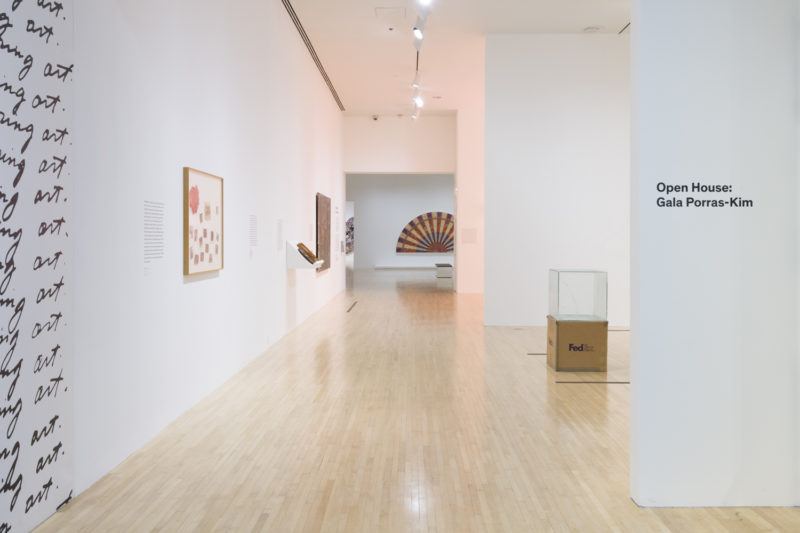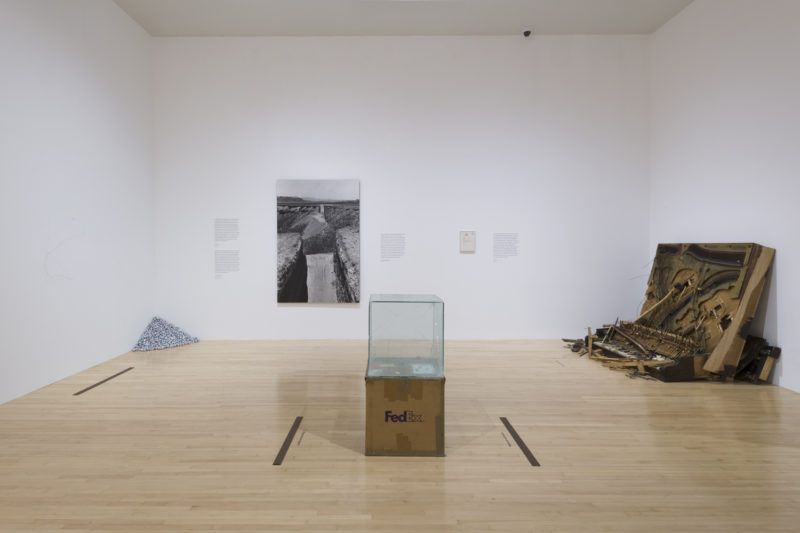Deep Focus
Gala Porras-Kim Negotiates Soft Power as an Artist-Curator

Installation view of “Open House: Gala Porras-Kim,” October 7, 2019–May 11, 2020 at MOCA Grand Avenue. Courtesy of The Museum of Contemporary Art. Photo by Jeff McLane.
How does an artist view a museum collection differently than a curator? In 2019, the Museum of Contemporary Art (MOCA) in Los Angeles introduced a series of exhibitions, titled Open House, to celebrate “the museum’s 40th anniversary and its permanent collection.”1 The series marks the first time in MOCA’s history that the museum invites L.A.-based artists to explore the permanent collection in order to organize shows through their own perspectives.
On view from October 7, 2019, through May 18, 2020, Open House: Gala Porras-Kim digs into the institution as both an archive and a mediator. [Ed. note: This article was commissioned prior to the museum’s temporary closure in response to COVID-19.] Porras-Kim’s work often investigates objects and their many lives, filtered through both the passage of time as well as institutional interpretations. With this exhibition, she focused specifically on works that defy the standard definition of an artwork as a static object. In the role of artist-curator, she opens up a new conversation. “The MOCA show is in between—it’s not necessarily my artwork and not necessarily a curated show,” Porras- Kim says2. “It’s both and neither at the same time.”

Installation view of “Open House: Gala Porras-Kim,” October 7, 2019–May 11, 2020 at MOCA Grand Avenue. Courtesy of The Museum of Contemporary Art. Photo by Jeff McLane.
Porras-Kim organized the exhibition in collaboration with Bryan Barcena, MOCA’s assistant curator and manager of publications, as well as Karlyn Olvido, a curatorial assistant. This created a different dynamic from that of a show organized only by an artist or by a curator. The theme of soft power weaves itself into these interactions. “I thought my relationship to the soft power of the institution was a one-way thing, where the museum would have to overpower my agency in some sense,” Porras-Kim says. “But there are many more, different stakeholders of an idea.”
—Gala Porras-Kim
Beyond a structural level, the exhibition also opened up a discussion about interpersonal exchanges within an institution. “In a sense, working in the studio, I feel like I’m the complete tyrant over all of the decisions made, which then I am responsible for,” Porras-Kim says. “But during the time of the show, I learned a lot about collaborating with other people and being able to decide with them how the idea of the show ended up taking shape. I appreciate the role of the curator more, now.”
These conversations naturally veer toward reflection about the artist’s intention, the audience’s interpretations, and the posterity of the work. “Like, with Kafka, I think about how he didn’t want his work published,” Porras-Kim says. “But is that good for the general public? Because [by us not following the artist’s wishes], they got to experience his works. I don’t have a clear answer for that.”
But some artists who do want their work posthumously displayed have been adept at leaving detailed instructions. For example, the works by Felix Gonzalez-Torres that make up part of Open House, Untitled (A Corner of Baci) from 1990 and Untitled (Last Light) from 1993, require careful assembly and more involved installation efforts than just hanging a painting on the wall. The same goes for Richard Tuttle’s 44th Wire Piece from 1972.

Installation view of “Open House: Gala Porras-Kim,” October 7, 2019–May 11, 2020 at MOCA Grand Avenue. Courtesy of The Museum of Contemporary Art. Photo by Jeff McLane.
Yet in an art institution with multiple departments and roles, other elements can come into play. For example, as Porras-Kim points out, what happens if a conservator breaks a piece? That event creates a new chapter in that artwork’s life; a department or person can exert a certain influence, even accidentally. “At different moments of an object’s life, different factions will have the power to decide what the fate of that object is,” Porras-Kim says. “So the [soft power is expressed in] how you negotiate with the other person who is also invested in that idea . . . [The object is] like a baby with four adoptive parents.”
Open House: Gala Porras-Kim invites the viewer to consider the many lives of each object—and the ways in which the objects’ places in art history might shift over the years. This becomes especially important when considering how the artists’ intentions for their works can never really be contained within the objects. The artwork lives a simultaneous life outside the four walls of the gallery, as memories of a visit or inspiration for future artists. Exhibitions like these ask that we stay curious about the way that artworks have simultaneous lives outside the four walls of a gallery.
1Open House: Elliott Hundley, Museum of Contemporary Art. Accessed 5 March 2020.
2Interview with the artist
